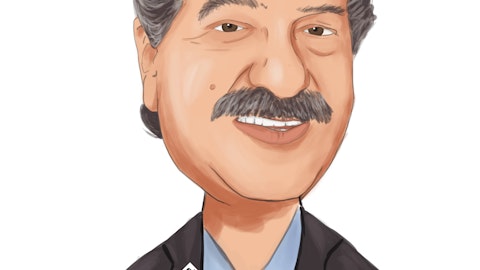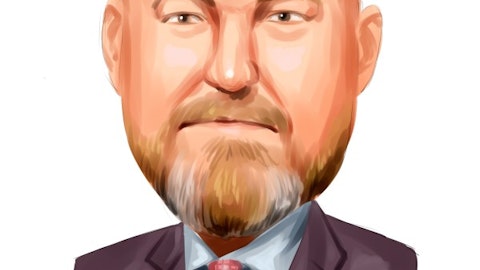NBT Bancorp Inc. (NASDAQ:NBTB) Q4 2022 Earnings Call Transcript January 24, 2023
Operator: Good day, everyone. Welcome to the conference call covering NBT Bancorp’s Fourth Quarter and Full Year 2022 Financial Results. This call is being recorded and made accessible to the public in accordance with the SEC’s Regulation FD. Corresponding presentation slides can be found on the company’s website at nbtbancorp.com. Before the call begins, NBT’s management would like to remind listeners that as noted on Slide 2, today’s presentation may contain forward-looking statements as defined by the Securities and Exchange Commission. Actual results may differ from those projected. In addition, certain non-GAAP measures will be discussed. Reconciliations for these numbers are contained within the appendix of today’s presentation.
At this time, all participants are in a listen-only mode. Later, we will conduct a question-and-answer session. Instructions will follow at that time. As a reminder, this call is being recorded. And I would now like to turn the conference over to NBT Bancorp President and CEO, John H. Watt, Jr. for his opening remarks. Mr. Watt, please begin.
John H. Watt, Jr.: Thank you, Chris, and good morning, and thank you for joining our earnings call covering NBT Bancorp’s fourth quarter and full year 2022 results. Joining me today are NBC’s Chief Financial Officer, Scott Kingsley; our Chief Accounting Officer, Annette Burns; and our Treasurer, Joe Ondesko. We achieved superior operating results for the full year 2022, defined by strong loan growth in connection with our strategy to build scale and create higher operating leverage. We’re very pleased to report operating earnings per share of $0.86 for the quarter and $3.55 for the year, excluding acquisition-related expenses and securities losses. Return on average assets was approximately 1.3% with return on tangible common equity for the year at 16.9%.
In a year underscored by volatile interest rate movements and unfavorable equity and fixed income market returns, we’re pleased that our operating results drove total shareholder returns of over 15% in 2022. Also, in line with our strategies around scale building, we were very pleased to announce an agreement to acquire Salisbury Bancorp in December. This all-stock transaction is expected to close in the second quarter of 2023, pending the required regulatory and Salisbury shareholder approvals. Loan growth was 10.2%, with our commercial and residential solar lending businesses finishing strong in the fourth quarter. Credit quality remained strong throughout the year with nonperforming loans down 4% in the fourth quarter. In 2022, our customers continued to embrace digital services with a 94% cumulative increase in consumer digital adoption since the start of 2020.
Across our markets, our commercial and business banking customers are active and their sentiment is generally optimistic. Projects funded by the 2021 infrastructure bill are moving ahead in upstate New York and our customers are bidding and winning their fair share: the planning work associated with the Micron chip fab plant build out near Syracuse has begun; and in Utica, New York, Wolfspeed recently announced a new large chip fabrication contract with Mercedes. NBT is preparing on many fronts to support our customers and communities across the Upstate New York chip corridor over the next five years. Yesterday, our Board approved a $0.30 dividend payable on March 15. In 2022, it’s notable that we marked 10 consecutive years of annual dividend increases and continued our commitment to providing consistent and favorable long-term returns for our shareholders.
So, I’ll conclude my remarks by emphasizing that it was the talented and dedicated team at NBT who made our 2022 results possible. We could not be more optimistic about how well that team has positioned us to enter 2023. With that said, I’ll turn the meeting over to Scott, who will walk you through the detail of our last quarter and the prior year. Scott, I’ll turn it over to you.
Scott Kingsley: Thank you, John, and good morning, everyone. Turning to the results overview page of our earnings presentation, our fourth quarter earnings per share were $0.84, and $0.86 per share excluding the $0.02 per share of acquisition expenses we incurred in the quarter related to our previously announced combination with Salisbury Bancorp. Fourth quarter operating results were consistent with the $0.86 a share reported in the fourth quarter of 2021 and $0.04 a share lower than the linked third quarter of 2022. These results were achieved despite a $7.5 million decline in PPP income recognition compared to the fourth quarter of last year or $0.13 a share. The improvement in net interest income over the two comparative quarters was the result of solid organic loan growth, incremental deployment of a portion of our excess liquidity into investment securities in the first half of the year and higher asset yields from the continued increases in the Federal Reserve’s targeted Fed funds rate.
We recorded a loan loss provision expense of $7.7 million in the fourth quarter compared to $3.1 million expense in the fourth quarter of 2021 or an $0.08 per share difference. Fourth quarter 2022’s loan loss provision was also $3.2 million or $0.06 a share higher than the $4.5 million provision recorded in the linked third quarter. Net charge-offs in the fourth quarter were $3.7 million or 18 basis points of loans compared to 22 basis points of loans in the fourth quarter of 2021 and 7 basis points of net charge-offs in the linked third quarter. Our reserve coverage increased slightly to 1.24% of loans from 1.22% at the end of September, which provided for loan growth. The next page shows trends in outstanding loans. Total loans were up $245 million for the quarter and included growth in both our consumer and commercial portfolios.
Loan yields were up 38 basis points from the third quarter of 2022, reflective of higher yields on our variable rate portfolios as well as new higher volume rates. Total loan portfolio of $8.15 billion remains very well diversified and is evenly balanced between consumer and commercial outstanding. Total deposits were down $423 million from the end of the third quarter and ended the year $739 million below the end of 2021 or 7.2% lower. The decrease in deposits was primarily concentrated in certain larger, more rate-sensitive accounts. The effects of tighter monetary policy, inflation and higher rate alternatives, including a laddered treasury security strategy deployed by our wealth management group for our own customers, continue to weigh on balances.
Even though deposit balances declined from 2021, year-end 2022 deposits are still 25% higher than the pre-pandemic end of 2019. During the fourth quarter, we shifted from an excess liquidity position to a net overnight borrowing position. Our quarterly cost of total deposits increased to 17 basis points compared to 9 basis points in the linked third quarter. Interest-bearing deposits moved up from 14 basis points in the third quarter to 27 basis points in the fourth quarter. And our total cost of funds increased 19 basis points from 18 basis points in the third quarter to 37 basis points in the fourth quarter. The next slide looks at detailed changes in our net interest income and margin. Net interest income increased $14.7 million as compared to the fourth quarter of last year and was up $5.4 million from the third quarter of 2022, reflective of higher yield on earning assets.

Research, Investment, Finance
Reported fourth quarter net interest margin was 3.68%, up 17 basis points from the linked third quarter and 60 basis points higher than the fourth quarter of 2021. With interest rates expected to continue to modestly rise in the near-term, the yields on our variable rate earning assets are expected to continue to move higher over the next few quarters. We also expect to reinvest cash flows from our interest-earning assets at levels above our current blended portfolio yields. Although we believe our deposit funding profile remains a core strength, we would expect increased levels of deposit beta in 2023. Going forward, retaining and growing deposits will continue to be a critical element of our ability to sustain the significant improvements we achieved in net interest margin during 2022.
The trends in noninterest income are summarized on the next page. Excluding security gains and losses, our fee income was down 17% from $3 million in the linked third quarter. Our retirement plan administration and wealth management businesses revenue decreased a combined $1.2 million, reflective of challenging market conditions as well as certain seasonally higher revenues in the third quarter. Similarly, fourth quarter revenues in our insurance agency are typically lower than the first three quarters of the year and were $450,000 below the linked third quarter. In 2022, on a full year basis, the company’s retirement plan administration business recognized $2.5 million of service revenues related to statutory plan document restatement requirements that generally recur on a six-year cycle.
Card services income decreased $3.9 million from the fourth quarter of 2021, driven by the bank being subject to the provisions of the Durbin Amendment to the Dodd-Frank Act beginning in the third quarter of 2022, which caps our per transaction compensatory opportunity for debit card interchange activities. Lower levels of card utilization and changes in transactional mix resulted in lower card services income in the fourth quarter compared to the linked third quarter. In addition, we continue to experience comparatively lower commercial lending fee opportunities in this rising interest rate environment. Turning now to noninterest expense. Our total operating expenses were $79.5 million for the quarter, which was $4.4 million or 5.9% above the fourth quarter of 2021 and $2.8 million or 3.7% higher than the linked third quarter and included $1 million of merger-related expenses incurred during the quarter.
Salaries and employee benefit costs of $47.2 million were 2.3% lower than the linked third quarter, reflective of one less payroll day in the quarter and more favorable experience in certain of our benefit plans. The quarter included some higher seasonal costs, including some external services for several tactical and strategic initiatives. We’d expect core operating expenses to drift modestly upward over the next several quarters as we continue our efforts to fill open positions in support of our customer engagement and growth objectives. We would also anticipate somewhat higher than historical levels of merit-based compensation increases in early 2023, probably 4% to 5%. In addition to investing in our people, we expect to continue to invest in technology-related applications and tools in order to advance our customer-facing and processing infrastructure.
On the next slide, we provide an overview of key asset quality metrics. A walk forward of our loan loss reserve changes is also available at the appendix of the presentation. As I previously mentioned, net charge-offs were 18 basis points in the fourth quarter of 2022 compared to 7 basis points in the prior quarter. In the selected financial data summary provided with the earnings release, we have summarized the components of our quarterly net charge-offs by line of business. Consistent with previous quarters, fourth quarter net charge-offs were concentrated in our other unsecured consumer portfolio, which are in a planned (ph) status. Nonperforming loans declined again this quarter. We are continuing to benefit from our conservative underwriting and have continued to experience higher than historical levels of recoveries.
As I wrap up my prepared remarks, some closing thoughts. We started 2022 on strong footing and are very pleased with the results we achieved. Improving net interest income, additive results from our diversified fee income line and favorable credit quality outcomes have more than offset higher levels of noninterest expense, which has allowed for productive gains in operating leverage. Our capital accumulation results over the past several quarters continue to put us in an enviable position as we consider growth opportunities for 2023 and beyond. With that, we’re happy to answer any questions you may have at this time. Chris?
See also 11 Best Aggressive Stocks To Buy Now and 15 Biggest Ice Cream Companies in the World.
Q&A Session
Follow Nbt Bancorp Inc (NASDAQ:NBTB)
Follow Nbt Bancorp Inc (NASDAQ:NBTB)
Operator: Thank you, sir. And our first question will come from Steve Moss of Raymond James. Your line is open.
Steve Moss: Hi, good morning.
Scott Kingsley: Good morning, Steve.
John H. Watt, Jr.: Good morning, Steve.
Steve Moss: Maybe just start off with loan growth here. You had good quarter for loan growth. And just kind of curious as to how the pipeline is now versus before. I hear you guys in terms of the ongoing investment in Upstate New York supporting business activity, but commercial growth was — continues to remain strong. Just curious as to expectations going forward.
John H. Watt, Jr.: Appreciate the question. First of all, with respect to economic development in Upstate New York, that’s a long-term growth opportunity for us. And as I said before, NBT is best when we are playing that long game. Those pipelines are going to build over periods of years, not immediately. Although, under the infrastructure funding that’s been released recently, several of our customers have been quite successful in receiving awards to be involved in large infrastructure projects. With respect to the commercial pipeline itself across the seven states, it’s healthy. Clearly, we did a lot in the fourth quarter to take a pending pipeline and convert it to close, and there’s refilling of the bucket going on. But we feel pretty good about the opportunities that we’re given to look at and the diversity of those opportunities.
On the consumer side, there’s no doubt that the residential mortgage business has slowed down. So, loan growth there is more muted and will be in this rate environment for a while. Although, on the back half of the year, we’ll see whether or not the housing market shifts again. We’re watching that very closely. We mentioned our growth in the Sungage lending program, very strong third and fourth quarter. I think Scott also will talk to that subject. We expect that to level off now going into this year as our partner Sungage diversifies its funding sources and it’s actively engaged in that. The beauty of that is we’ll retain the servicing in all likelihood and there’ll be other investors to hold the asset. So, generally speaking, optimistic with those exceptions.
Steve Moss: Okay. That’s helpful. And then, maybe just on loan pricing, what’s the rate on new loans coming on these days, and any color you can give there?
Scott Kingsley: Sure. So, sort of holistically across the board, Steve, new loan production is clearly above 6% in all of our portfolios. From a pricing standpoint, I think that discipline in the market around us has been pretty fair as people have started to experience some increase in some of their funding costs or have actually started to experience a little bit less excess liquidity on their balance sheet. I think some of that discipline is even a little bit more pronounced, which is what we’re seeing in the market today. So, important for us going forward from a pricing standpoint, price to the forward curve, I think as most people have probably noted, 2022 probably didn’t force that until at least the midyear point of the year or maybe even later because of the excess liquidity that exists on most banks’ balance sheet at the time.
But I think generally, we’re not getting a lot of pushback relative to our pricing proposals that are out there today. And they are certainly at levels of yields that are meaningfully above the blended portfolio that’s on the books today.
Steve Moss: Okay. That’s helpful. And then, maybe just one last one for me. If we get 25 basis points in February and 25 basis points in March, just kind of curious how you guys are thinking about the margin. I mean, I hear you there’s some uptick in deposit costs, but just curious how to think about that in the next couple of quarters.
Scott Kingsley: Yes. For us, I think we probably would have told you a quarter ago that we would have thought that, that would have allowed for a little bit of the tick up in net interest margin expansion possibilities. I think with the drop in funding levels in the fourth quarter, probably a little bit more cautious about that than we were in September. So, yes, I think we’ll get improvement relative to variable rate assets with those two moves, and we’re anticipating that. The question is can we still find the logical sources. I think as, probably, we pointed out before, I mean our deposit beta remains very low. We have a very granular deposit base. But to the extent that we’ve had drops in balances, not drops in relationships, but drops in balances, those have been primarily focused on our largest 150 customers.
And I think as, again, most people realize short-term treasury yield at the front end of the curve are in the high 4%-s today. And people with the high treasury acumen, some we’re helping and others have got there without us, have just found other opportunities in a higher yielding. So, Steve, to come back around to your question, I think we’d like to believe that NIM stability is a possibility for the first half of the year, but I think that will be incumbent upon us holding our funding sources in place.
Steve Moss: Okay, great. Thank you very much for all the color.
Scott Kingsley: Appreciate it, Steve. Thanks for the questions.
John H. Watt, Jr.: Thanks, Steve.
Operator: Thank you. And our next question will come from the line of Alex Twerdahl of Piper Sandler & Company. Your line is open.
Alex Twerdahl: Hey, good morning, guys.
Scott Kingsley: Hey, good morning, Alex.
John H. Watt, Jr.: Good morning, Alex.





